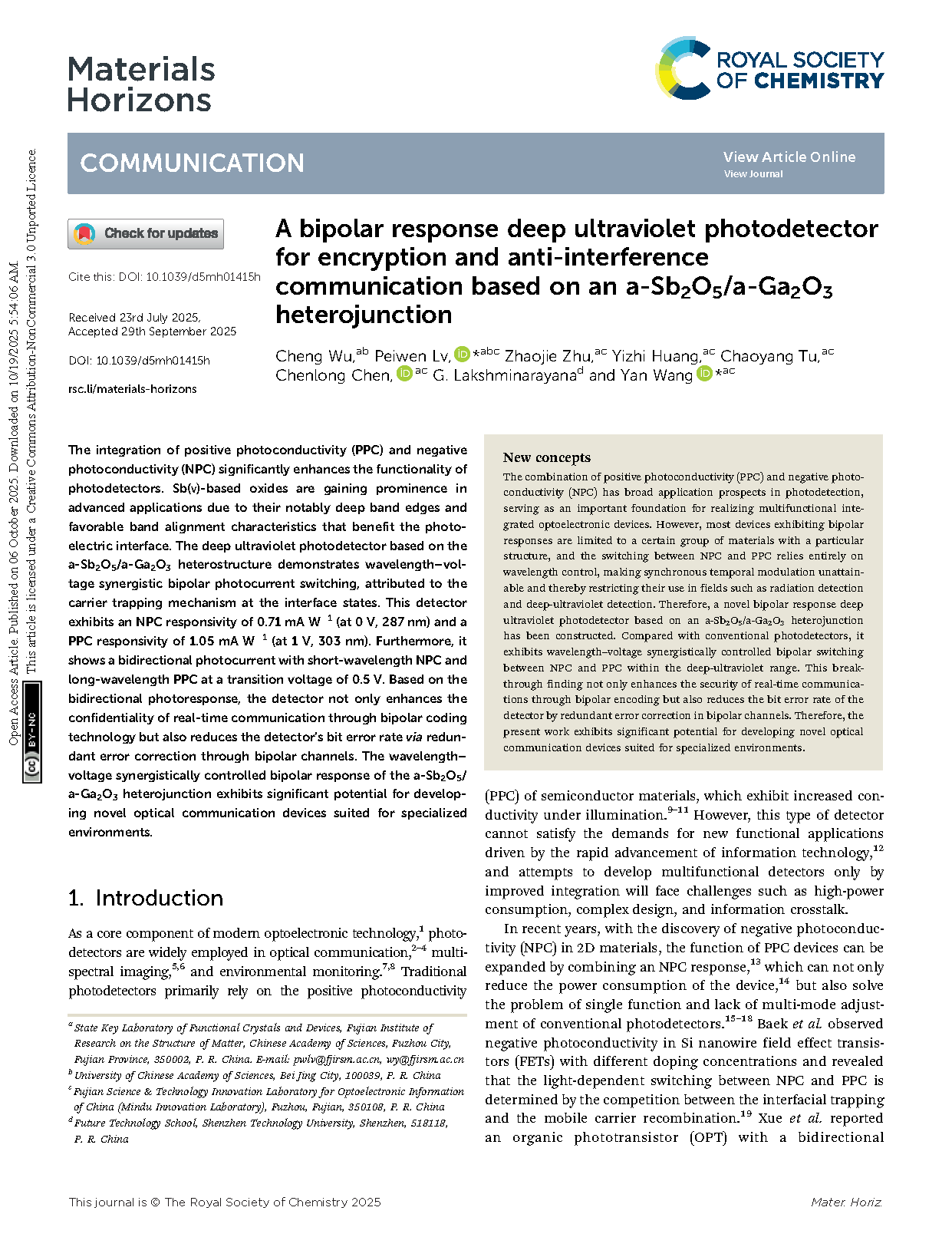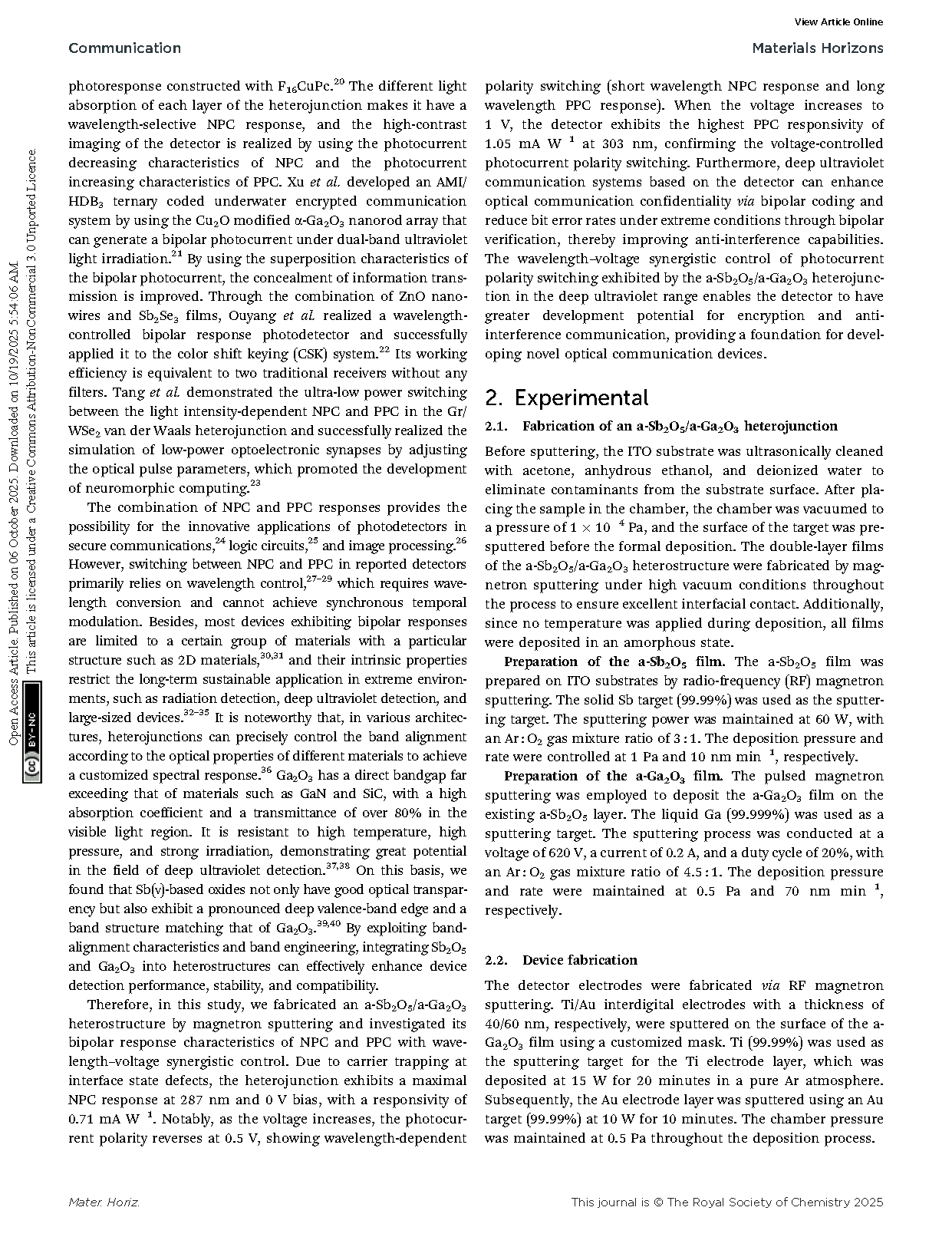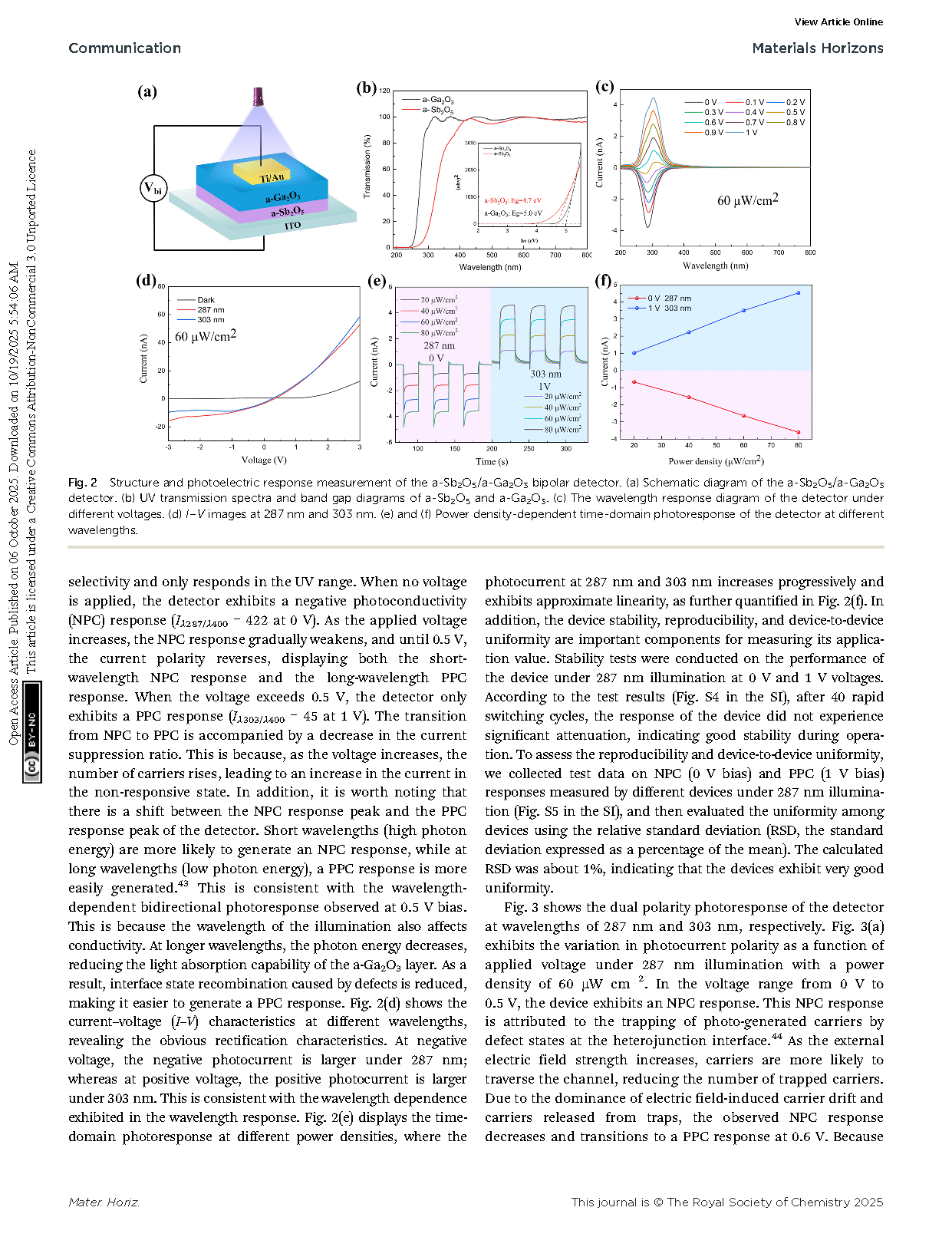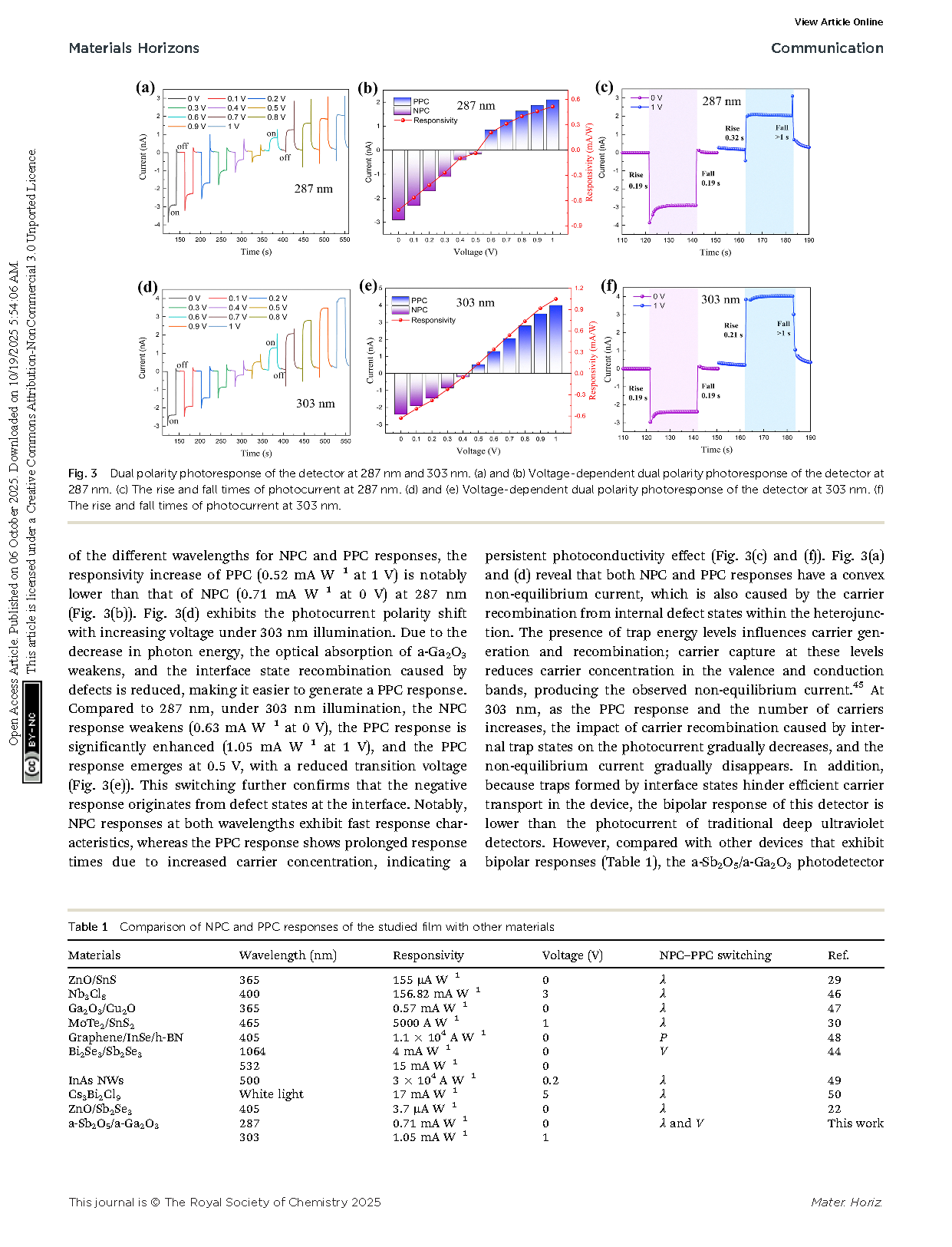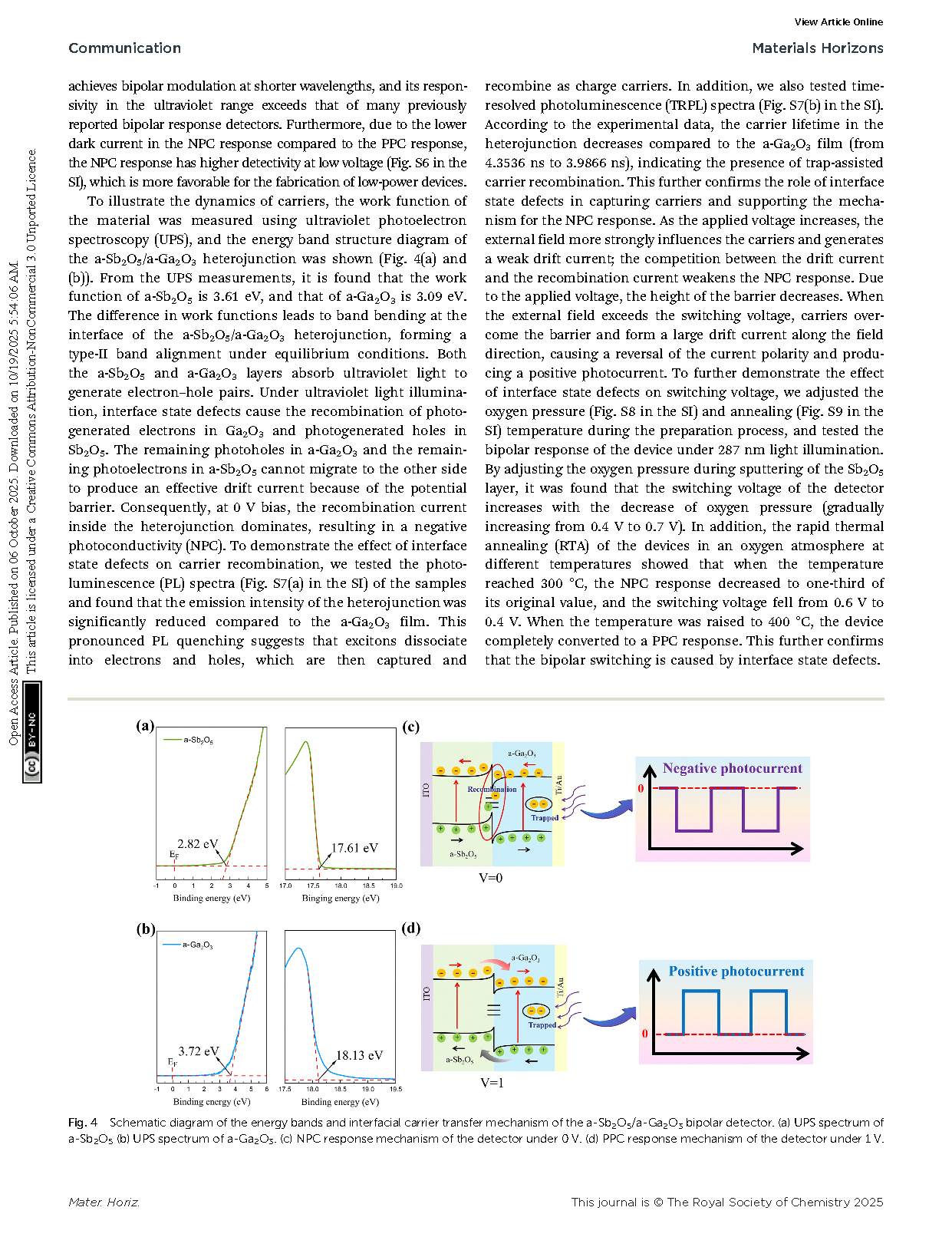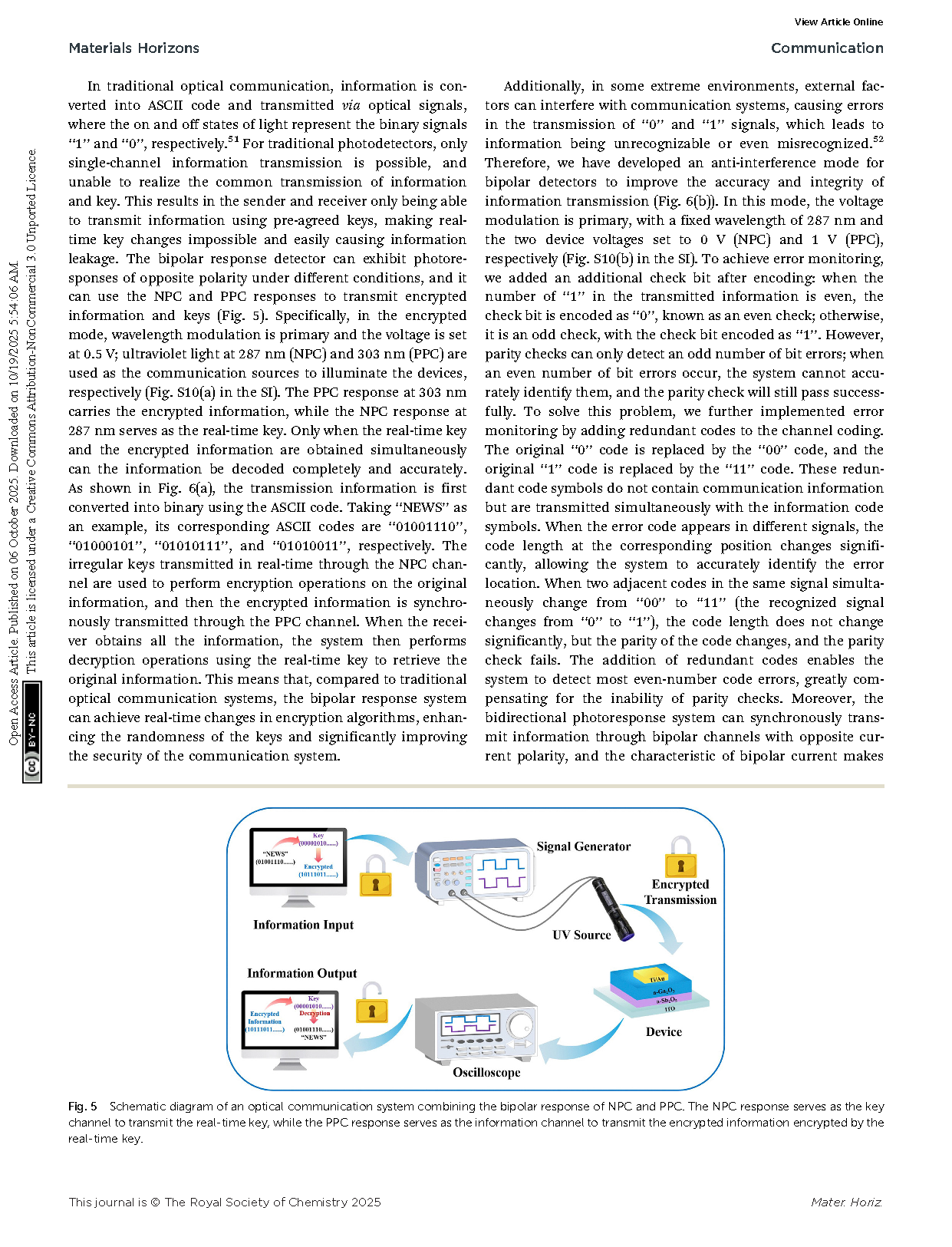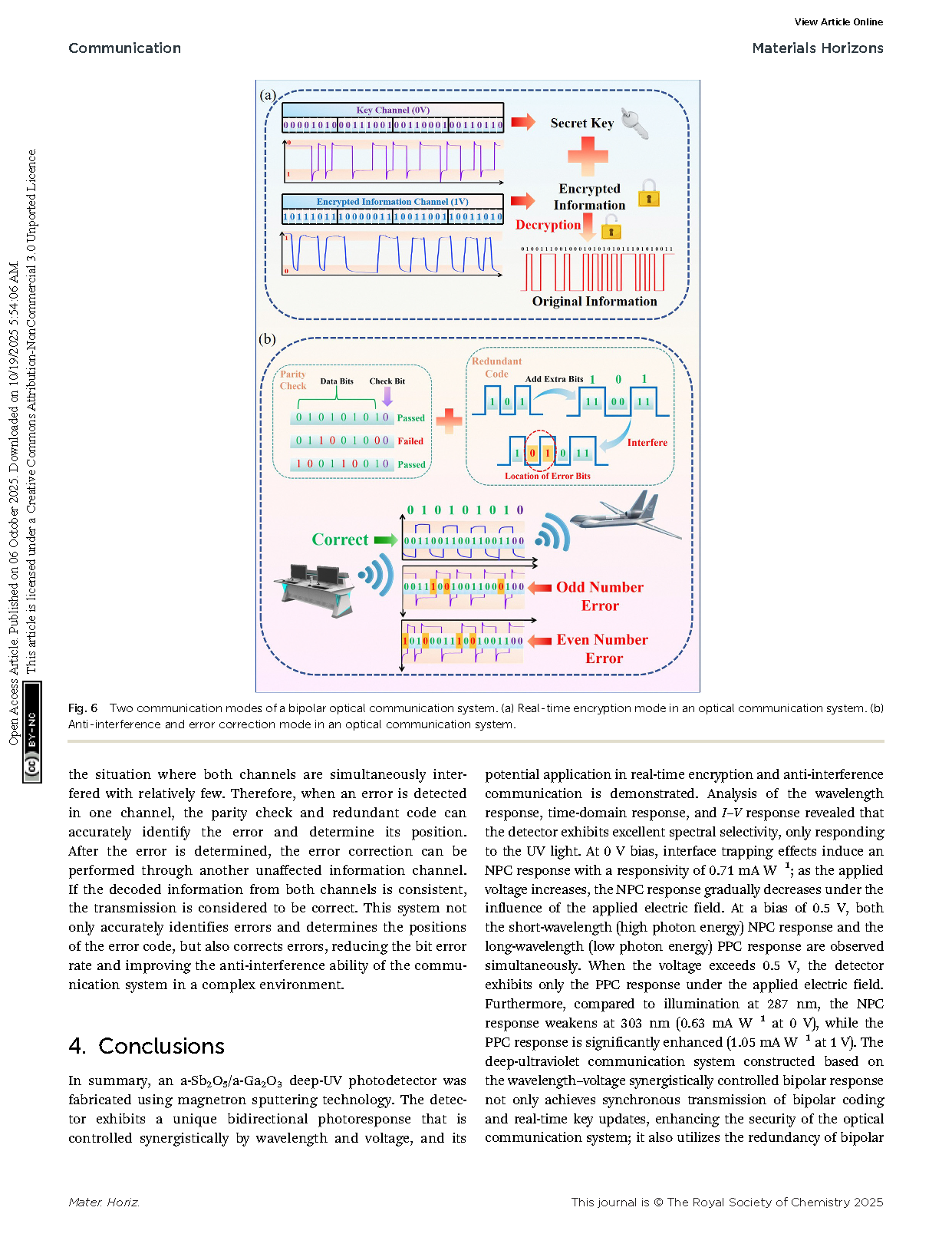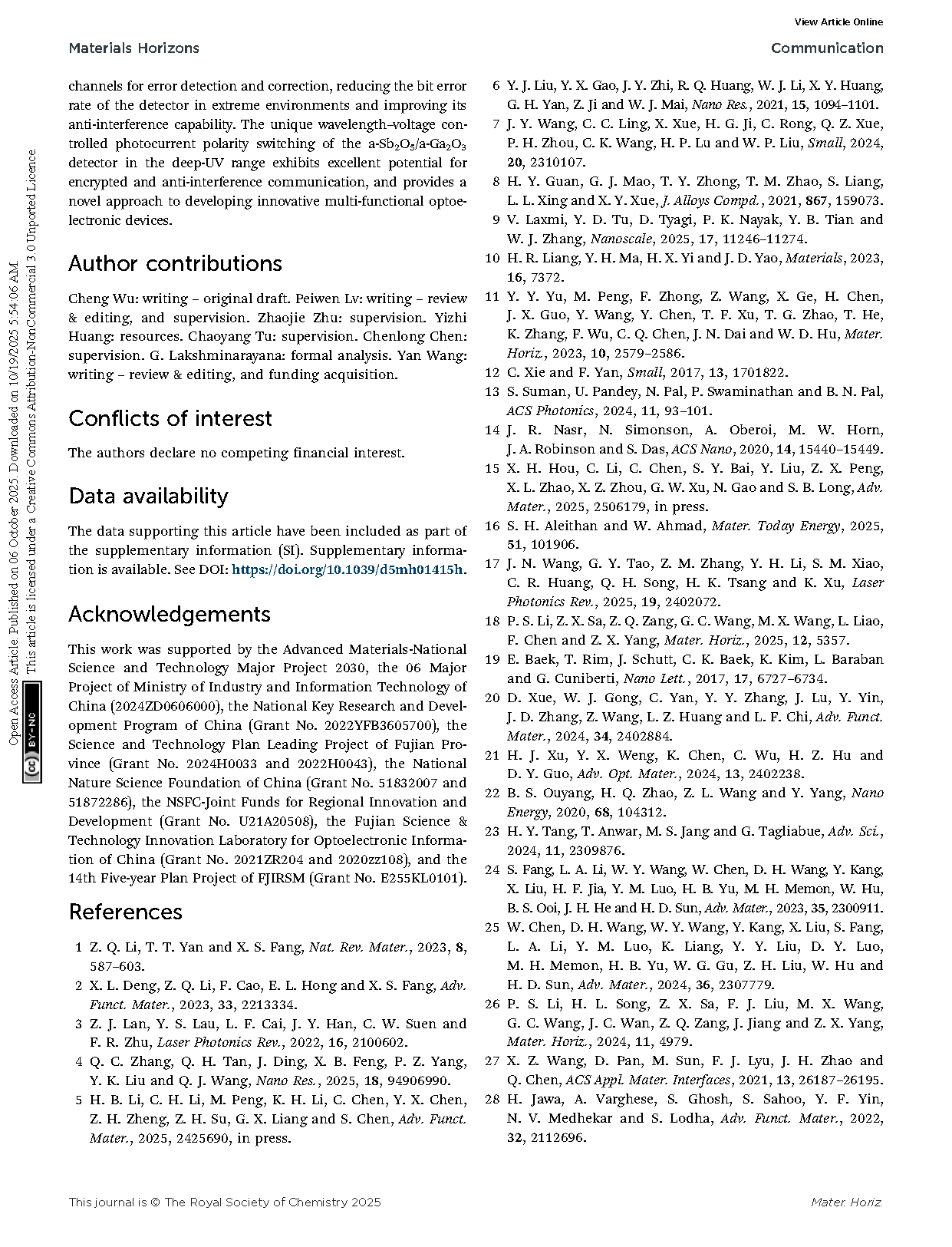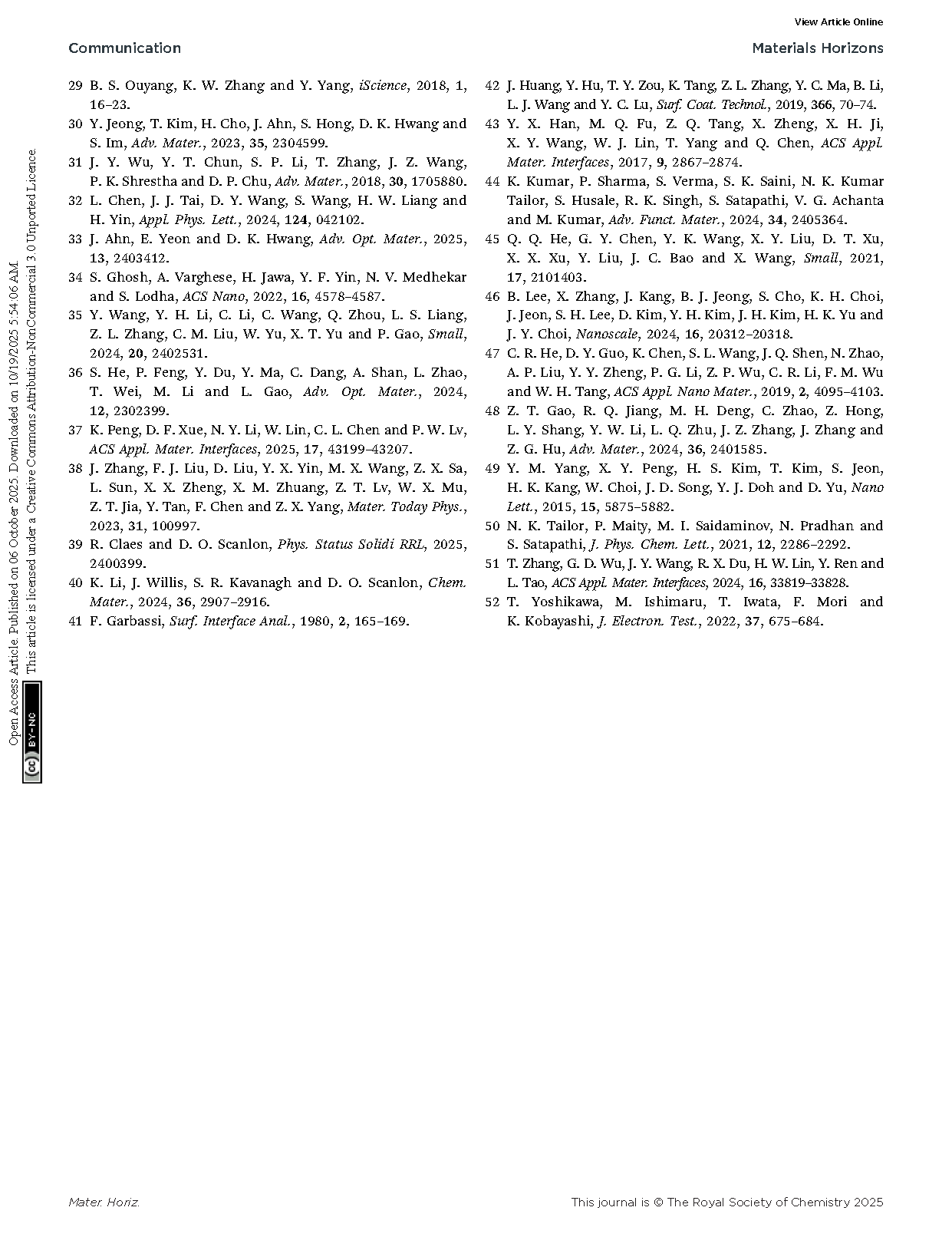

【Domestic Papers】A bipolar response deep ultraviolet photodetector for encryption and anti-interference communication based on an a-Sb₂O₅/a-Ga₂O₃ heterojunction
日期:2025-10-30阅读:163
Researchers from the Fujian Institute of Research on the Structure of Matter have published a dissertation titled "A bipolar response deep ultraviolet photodetector for encryption and anti-interference communication based on an a-Sb2O5/a-Ga2O3 heterojunction" in Materials Horizons.
Project Support
This work was supported by the Advanced Materials-National Science and Technology Major Project 2030, the 06 Major Project of Ministry of Industry and Information Technology of China (2024ZD0606000), the National Key Research and Development Program of China (Grant No. 2022YFB3605700), the Science and Technology Plan Leading Project of Fujian Province (Grant No. 2024H0033 and 2022H0043), the National Nature Science Foundation of China (Grant No. 51832007 and 51872286), the NSFC-Joint Funds for Regional Innovation and Development (Grant No. U21A20508), the Fujian Science & Technology Innovation Laboratory for Optoelectronic Information of China (Grant No. 2021ZR204 and 2020zz108), and the 14th Five-year Plan Project of FJIRSM (Grant No. E255KL0101).
Background
As a core component of modern optoelectronic technology,1 photodetectors are widely employed in optical communication, multispectral imaging, and environmental monitoring. Traditional photodetectors primarily rely on the positive photoconductivity (PPC) of semiconductor materials, which exhibit increased conductivity under illumination. However, this type of detector cannot satisfy the demands for new functional applications driven by the rapid advancement of information technology, and attempts to develop multifunctional detectors only by improved integration will face challenges such as high-power consumption, complex design, and information crosstalk.
Abstract
The integration of positive photoconductivity (PPC) and negative photoconductivity (NPC) significantly enhances the functionality of photodetectors. Sb(V)-based oxides are gaining prominence in advanced applications due to their notably deep band edges and favorable band alignment characteristics that benefit the photoelectric interface. The deep ultraviolet photodetector based on the a-Sb2O5/a-Ga2O3 heterostructure demonstrates wavelength–voltage synergistic bipolar photocurrent switching, attributed to the carrier trapping mechanism at the interface states. This detector exhibits an NPC responsivity of 0.71 mA W−1 (at 0 V, 287 nm) and a PPC responsivity of 1.05 mA W−1 (at 1 V, 303 nm). Furthermore, it shows a bidirectional photocurrent with short-wavelength NPC and long-wavelength PPC at a transition voltage of 0.5 V. Based on the bidirectional photoresponse, the detector not only enhances the confidentiality of real-time communication through bipolar coding technology but also reduces the detector's bit error rate via redundant error correction through bipolar channels. The wavelength–voltage synergistically controlled bipolar response of the a-Sb2O5/a-Ga2O3 heterojunction exhibits significant potential for developing novel optical communication devices suited for specialized environments.
Conclusions
In summary, an a-Sb2O5/a-Ga2O3 deep-UV photodetector was fabricated using magnetron sputtering technology. The detector exhibits a unique bidirectional photoresponse that is controlled synergistically by wavelength and voltage, and its potential application in real-time encryption and anti-interference communication is demonstrated. Analysis of the wavelength response, time-domain response, and I–V response revealed that the detector exhibits excellent spectral selectivity, only responding to the UV light. At 0 V bias, interface trapping effects induce an NPC response with a responsivity of 0.71 mA W−1; as the applied voltage increases, the NPC response gradually decreases under the influence of the applied electric field. At a bias of 0.5 V, both the short-wavelength (high photon energy) NPC response and the long-wavelength (low photon energy) PPC response are observed simultaneously. When the voltage exceeds 0.5 V, the detector exhibits only the PPC response under the applied electric field. Furthermore, compared to illumination at 287 nm, the NPC response weakens at 303 nm (0.63 mA W−1 at 0 V), while the PPC response is significantly enhanced (1.05 mA W−1 at 1 V). The deep-ultraviolet communication system constructed based on the wavelength–voltage synergistically controlled bipolar response not only achieves synchronous transmission of bipolar coding and real-time key updates, enhancing the security of the optical communication system; it also utilizes the redundancy of bipolar channels for error detection and correction, reducing the bit error rate of the detector in extreme environments and improving its anti-interference capability. The unique wavelength–voltage controlled photocurrent polarity switching of the a-Sb2O5/a-Ga2O3 detector in the deep-UV range exhibits excellent potential for encrypted and anti-interference communication, and provides a novel approach to developing innovative multi-functional optoelectronic devices.

Fig.1 Morphology and structural characterization of Sb2O5/a-Ga2O3 heterojunctions. (a) SEM image of the interface of the a-Sb2O5/a-Ga2O3 heterojunction. (b) AFM image of a-Sb2O5. (c) XPS image of a-Sb2O5. (d) AFM image of a-Ga2O3. (e) and (f) XPS images of a-Ga2O3.
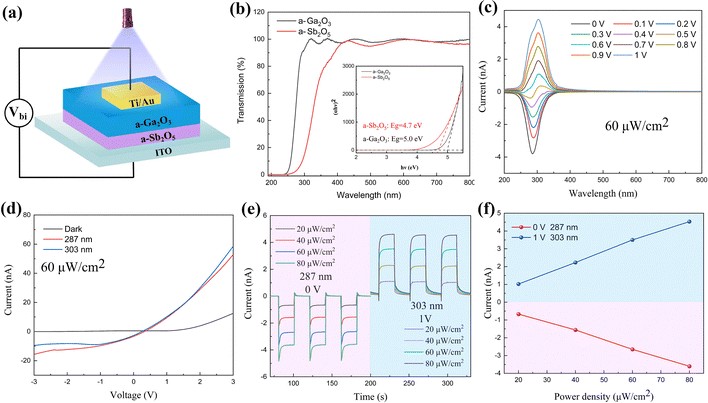
Fig.2 Structure and photoelectric response measurement of the a-Sb2O5/a-Ga2O3 bipolar detector. (a) Schematic diagram of the a-Sb2O5/a-Ga2O3 detector. (b) UV transmission spectra and band gap diagrams of a-Sb2O5 and a-Ga2O3. (c) The wavelength response diagram of the detector under different voltages. (d) I–V images at 287 nm and 303 nm. (e) and (f) Power density-dependent time-domain photoresponse of the detector at different wavelengths.

Fig. 3 Dual polarity photoresponse of the detector at 287 nm and 303 nm. (a) and (b) Voltage-dependent dual polarity photoresponse of the detector at 287 nm. (c) The rise and fall times of photocurrent at 287 nm. (d) and (e) Voltage-dependent dual polarity photoresponse of the detector at 303 nm. (f) The rise and fall times of photocurrent at 303 nm.
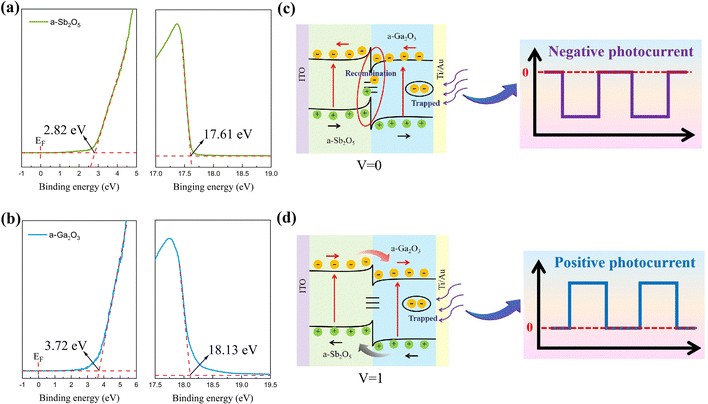
Fig. 4 Schematic diagram of the energy bands and interfacial carrier transfer mechanism of the a-Sb2O5/a-Ga2O3 bipolar detector. (a) UPS spectrum of a-Sb2O5 (b) UPS spectrum of a-Ga2O3. (c) NPC response mechanism of the detector under 0 V. (d) PPC response mechanism of the detector under 1 V.
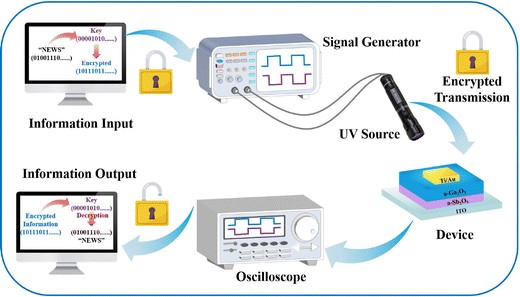
Fig. 5 Schematic diagram of an optical communication system combining the bipolar response of NPC and PPC. The NPC response serves as the key channel to transmit the real-time key, while the PPC response serves as the information channel to transmit the encrypted information encrypted by the real-time key.
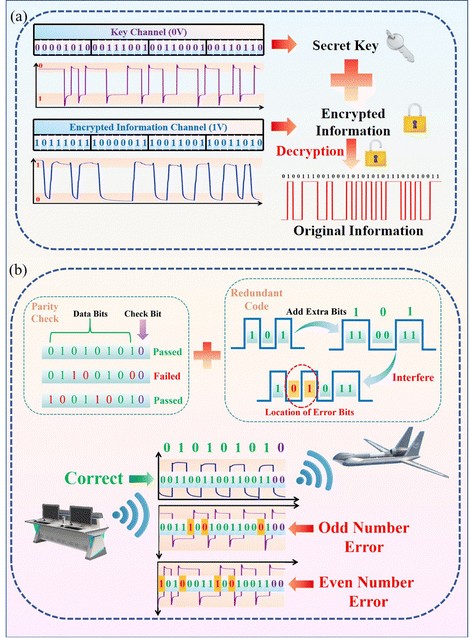
Fig. 6 Two communication modes of a bipolar optical communication system. (a) Real-time encryption mode in an optical communication system. (b) Anti-interference and error correction mode in an optical communication system.
DOI:
doi.org/10.1039/D5MH01415H
